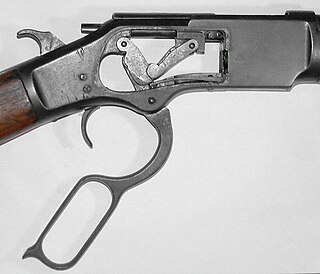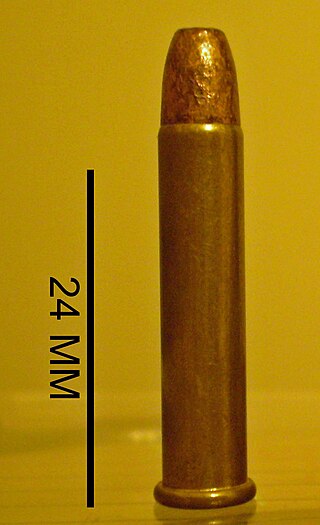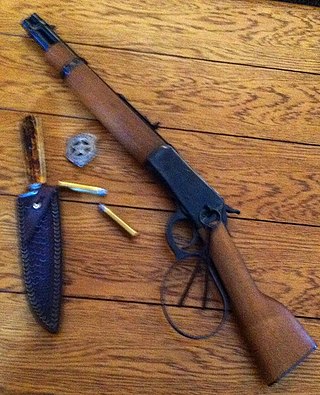
In firearm designs, the term single-shot refers to guns that can hold only a single round of ammunition inside and thus must be reloaded manually after every shot. Compared to multi-shot repeating firearms ("repeaters"), single-shot designs have no moving parts other than the trigger, hammer/firing pin or frizzen, and therefore do not need a sizable receiver behind the barrel to accommodate a moving action, making them far less complex and more robust than revolvers or magazine/belt-fed firearms, but also with much slower rates of fire.

In firearms terminology, an action is the functional mechanism of a breech-loading firearm that handles the ammunition cartridges, or the method by which that mechanism works. Actions are technically not present on muzzleloaders, as all those are single-shot firearms with a closed off breech with the powder and projectile manually loaded from the muzzle. Instead, the muzzleloader ignition mechanism is referred to as the lock.
Winchester rifle is a comprehensive term describing a series of lever action repeating rifles manufactured by the Winchester Repeating Arms Company. Developed from the 1860 Henry rifle, Winchester rifles were among the earliest repeaters. The Model 1873 was particularly successful, being marketed by the manufacturer as "The Gun That Won the West".

A lever action is a type of action for repeating firearms that uses a manually operated cocking handle located around the trigger guard area that pivots forward to move the bolt via internal linkages, which will feed and extract cartridges into and out of the chamber, and cock the firing pin mechanism. This contrasts to other type of repeating actions such as the bolt-action, pump-action, semi-automatic, fully automatic, and/or burst mode actions. A firearm using this operating mechanism is colloquially referred to as a levergun.

The .45 Colt (11.43×33mmR), is a rimmed, straight-walled, handgun cartridge dating to 1872. It was originally a black-powder revolver round developed for the Colt Single Action Army revolver. This cartridge was adopted by the U.S. Army in 1873 and served as an official US military handgun cartridge for 19 years, before being replaced by the .38 Long Colt in 1892.

The .44 Remington Magnum, also known as .44 Magnum or 10.9x33mmR, is a rimmed, large-bore cartridge originally designed for revolvers and quickly adopted for carbines and rifles. Despite the ".44" designation, guns chambered for the .44 Magnum round, its parent case, the .44 Special, and its parent case, the .44 Russian all use 0.429 in (10.9 mm) diameter bullets. The .44 Magnum is based on the .44 Special case but lengthened and loaded to higher pressures for greater velocity and energy.

The .22 Winchester Magnum Rimfire, also known as the .22 WMR, .22 Magnum, .22 WMRF, .22 MRF, or .22 Mag, is a rimfire cartridge. Originally loaded with a bullet weight of 40 grains (2.6 g) delivering velocities in the 2,000 feet per second (610 m/s) range from a rifle barrel, .22 WMR is now loaded with bullet weights ranging from 50 grains (3.2 g) at 1,530 feet per second (470 m/s) to 30 grains (1.9 g) at 2,200 feet per second (670 m/s).
The Winchester Repeating Arms Company was a prominent American manufacturer of repeating firearms and ammunition. The firm was established in 1866 by Oliver Winchester and was located in New Haven, Connecticut. The firm went into receivership in 1931 and was bought by the Western Cartridge Company, a forerunner of the Olin Corporation. The Winchester brand name is still owned by the Olin Corporation, which makes ammunition under that name. The Winchester name is also used under license for firearms produced by two subsidiaries of the Herstal Group – FN Herstal of Belgium and the Browning Arms Company of Ogden, Utah.
Marlin Firearms is an American manufacturer of semi-automatic, lever-action and bolt-action rifles. In the past the company made shotguns, derringers, and revolvers. Marlin owned the firearm manufacturer H&R Firearms. In 2007, Remington Arms, part of the Remington Outdoor Company, acquired Marlin Firearms. Remington produced Marlin-brand firearms at its Kentucky and New York manufacturing facilities. In 2020, Sturm, Ruger & Co. bought the Marlin business from bankrupt Remington Outdoor Company.
The Henry repeating rifle is a lever-action tubular magazine rifle famed both for its use at the Battle of the Little Bighorn and being the basis for the iconic Winchester rifle of the American Wild West.

The Remington Model 14 is a pump-action repeating rifle designed for the Remington Arms company by John Pedersen. It is part of a series of rifles that include the Remington Model 14-1/2 and the Remington Model 141.
The Marlin Model 336 is a lever-action rifle and carbine made by Marlin Firearms. Since its introduction in 1948, it has been offered in a number of different calibers and barrel lengths, but is commonly chambered in .30-30 Winchester or .35 Remington, using a 20- or 24-inch barrel. Currently, the model with a 24-inch barrel is only available in .30-30 Winchester. The Model 336 is now back in production as of March 27, 2023.
The Winchester Model 1894 rifle is a lever-action repeating rifle that became one of the most famous and popular hunting rifles of all time. It was designed by John Browning in 1894 and originally chambered to fire two metallic black powder cartridges, the .32-40 Winchester and .38-55 Winchester. It was the first rifle to chamber the smokeless powder round, the .30 WCF in 1895. In 1901, Winchester created the new .32 Winchester Special caliber with production of rifles starting in 1902.

The Browning BLR is a lever-action rifle manufactured for Browning Arms Company by Miroku Firearms in Japan. It comes in many different variations and is chambered in numerous calibers from small and fast to the large Magnum rounds, and the large bore .450 Marlin.

The Marlin Model 1894 is a lever-action repeating rifle introduced in 1894 by the Marlin Firearms Company of North Haven, Connecticut. At its introduction the rifle came with a 24-inch barrel and was chambered for a variety of rounds such as .25-20 Winchester, .32-20 Winchester, .38-40, and .44-40. Variants in other chamberings remain in production today.

The Mare's Leg is the name given to a customized shortened rifle used by Steve McQueen's character on the television series Wanted: Dead or Alive (1958–1961). McQueen's character was named Josh Randall. Mare's Leg is now a generic term for a Winchester Model 1892 with a shortened barrel and stock.
The Winchester Model 1886 was a lever-action repeating rifle designed by John Browning to handle some of the more powerful cartridges of the period. Originally chambered in .45-70 Government, .45-90 Sharps, and .40-82 Winchester, it was later offered in a half dozen other large cartridges, including the .50-110 Winchester. Despite being originally designed for use with black powder, the action was strong enough to make the jump to smokeless powder with only minor modifications, and was subsequently chambered in the smokeless .33 Winchester cartridge beginning in 1903.

Richard J. Casull was a Salt Lake City-born gunsmith and wildcat cartridge developer whose experiments with .45 Colt ammunition in the 1950s led to the creation of the .454 Casull cartridge. Casull's passion was six-shooters, and he was determined to create a high velocity round for the .45 Colt. His goal was to achieve a muzzle velocity of 2,000 feet per second with Colt .45 rounds fired from a single-action Army-style revolver with a 7+1⁄2inch barrel. This proved impossible due to the tensile strength of the Colt .45 cylinder, so he set out to develop his own casing and bullet.

The Colt-Burgess rifle, also known as the 1883 Burgess rifle or simply the Burgess rifle, is a lever-action repeating rifle produced by Colt's Patent Firearms Manufacturing Company between 1883 and 1885. The Burgess rifle was Colt's only entrance into the lever-action rifle market, produced to compete with Winchester Repeating Arms Company's line of popular rifles. The 1883 Burgess rifle was designed and patented by Andrew Burgess, an American firearms designer and photographer, who sold the design to Colt.

The .45-60 Winchester is a centerfire rifle cartridge intended for 19th-century big-game hunting. Nomenclature of the era indicated the .45-60 cartridge contained a 0.45-inch (11.43 mm) diameter bullet with 60 grains (3.89 g) of black powder. Winchester Repeating Arms Company shortened the .45-70 Government cartridge to operate through the Winchester Model 1876 rifle's lever-action.

















